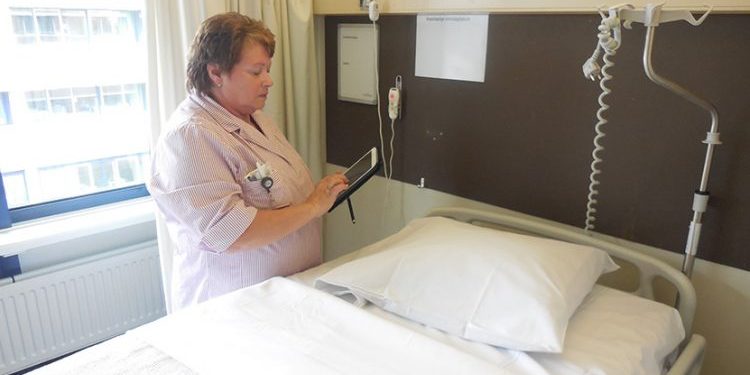The cleaning in St. Antonius Hospital Nieuwegein and Utrecht is carried out in-house. To monitor this own service, the Facilities & Property department uses the Daily Control System (DKS). A software application from GRIP – facility Data Solutions software partner of cleaning consultancy firm Atir – has recently also been used, which makes checks more efficient, transparent and professional
The cleaning maintenance of the locations of the St. Antonius Hospital in Utrecht and Nieuwegein is done in-house, with the exception of the outpatient clinics at the Nieuwegein location. A division into employee groups has been made for the performance of the activities. The nursing wards are cleaned by room service staff. In addition to carrying out cleaning work, they are also responsible for the provision of food to patients, the supply of materials in the department (for example bandages and linen provision) and the delivery of mail. The other areas are maintained by cleaning staff. They only carry out cleaning work and are managed by team leaders and foremen. They are again led by Wenny Braam, head of the Services department. The St. Antonius Hospital has deliberately opted for its own cleaning service. Wenny: ‘We manage part of the cleaning in the house, because we believe that with our own service we can respond more flexibly to the demand of our customers. The service is professionally approached at our locations. For example, in 2012, together with SVS, we developed a tailor-made cleaning course with our own course material specifically aimed at the St. Antonius Hospital. This training is enthusiastically received by our employees and contributes to a professional performance of the work.
DKS software
The next step in the professionalization of our own cleaning service was the structural assessment of the technical quality. For this, the St. Antonius Hospital has started using VSR-DKS (the Daily Control System developed by the Cleaning Research Association). This control system helps employees to optimize the execution process. Wenny says about this: ‘We started to have the measurements carried out by an independent employee and to work out the results manually. I then developed an app for the smartphone to immediately get results in an Excel file and thus make the process more efficient. At the beginning of 2015, we got into a conversation with Rob Toorenburgh, consultant at consultancy firm Atir. He advised us on various cleaning issues. During this conversation, we became acquainted with GRiP, a web-based platform for dashboard reporting that, with supporting applications, can provide insight into the performance of various facility services.” Wenny decided to start a pilot using the DKS app that allows the DKS measurements are performed. “The results of the measurement are immediately visible in the GRiP dashboard. The dashboard provides an overall picture of the cleaning quality in the hospital. If desired, we can zoom in on department or even task level.” “After the successful pilot, we proceeded to purchase GRiP for the entire hospital. I think the strength of the system lies in the direct insight into the dashboard. This shows whether the quality standard that we have agreed with our customers is being met. If the score is too low, adjustments can be made immediately and a re-measurement takes place to determine whether the standard has been met. The results of the measurements are also the basis for the discussions with our customers and the executive employees. As a department, we have set a standard of 8.5. That is high, but we also want a high level of service for our customers. And that we can deliver that, is evident from the average result that is above 9.0.”
Inventory
To monitor the cleaning quality, the quality is measured four times a year by Hermanda van der Lingen in every department of the St. Antonius Hospital. As a quality employee, Hermanda is responsible for the right quality level, in addition to a number of other facility tasks. The DKS gives her something to hold on to and offers insights to monitor quality on a daily basis. Hermanda: ‘Because we want a numerical result, it is important that the elements in a room are counted. This was disappointing in the beginning (in all rooms the elements that must be cleaned according to the cleaning program had to be inventoried, ed.) But now that this has been done, it saves me a lot of time.’ A consequence of the inventory and automation. ‘In the beginning it took some getting used to doing the measurements with a tablet. But now I can do twenty to twenty-five meti.’

